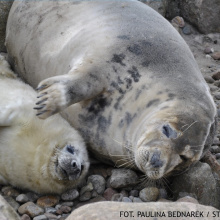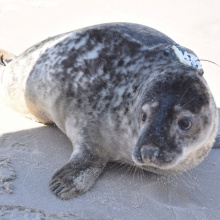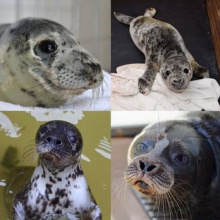Ewa Karolina Cichocka talks with dr Iwona Pawliczka vel Pawlik, Head of the prof. Krzysztof Skóra Marine Station UG in Hel about the time of a seal birth, the intensified work of the Station, and the attentiveness of people walking the beaches at the turn of February and March.
- February 12th marks the sixth anniversary of prof. Krzysztof Skóra's passing, the founder and long-time head of the Marine Station of the Institute of Oceanography at the University of Gdańsk in Hel. The Station bears his name, and last year a special plaque commemorated him. There is a commemorative film on your website to this day. This is a difficult time for the Station's crew...
- Every anniversary we commemorate, as the crew of the Marine Station, that very sad day when our Captain left the ship he commanded for nearly 40 years. He is still among us, and we try to continue what he taught us - to care for the marine environment by improving our knowledge, education and advice in managing its protection.
- This is a time for reflection, but also the Station's staff to work hard and intensively. Now, at the end of February and the beginning of March, you are continuing the life work of your Mentor in the most exceptional way?
- We continue them practically every day because it was his life's work to make the public aware of the need to protect the Baltic Sea environment. Probably everyone who at least once had the opportunity to listen to Professor, found in themselves a place for reflection on how to deal with marine nature with respect and how to ensure its harmonious functioning, also to meet human needs.
- In a little while, small, fluffy grey seals will begin to appear on the floes and beaches of the Baltic Sea. What does this time mean for the employees and volunteers of the Station?
- The Station runs a seal rehabilitation centre and it happens that some of these babies, soon after being born, end up in our Centre or other similar centres on the Baltic Sea. We never know what a given year will bring, because it largely depends on the weather conditions in the places where grey seals are born - on the Estonian, Finnish or Swedish coasts. To us, the sea brings those that lost contact with their mothers too soon and are not yet fully prepared for independent life.
- The grey seal population in the Baltic Sea is over 40 thousand individuals. Are there more and more seals in our waters? Are they being born on our shores?
- The seal colony in the mouth of the Vistula Dug-through seems to be as stable as the meteorological and hydrodynamic conditions prevailing there at the time allowed. Due to the high mobility of sandy backwaters, where seals rest, we can observe there from a few to several hundred individuals. But as the grey seal is a migratory species, as the Baltic population increases, their numbers may also increase in our waters, even though they have not yet reproduced on our shores.
- Why do baby seals need human help? What happens to them after they are cured at the Station?
- Puppies, who lose contact with their mothers too early and are not prepared for independent life, most often need human help. Their care consists either in helping them to become independent or in treating or healing the wounds they have suffered in the wild. All seals that we manage to successfully prepare for life in the wild return there as soon as possible. We follow the fate and migrations of some of them through satellite transmitters, that inform us about their whereabouts.
- How should we behave when we see a seal baby on the shore, and what should we definitely not do?
- We use in the public domain the appeal Give the seal a break! This is what we mean when we meet a seal on the beach - not to disturb it, not to scare it, not to frighten it, not to try to feed it or even come too close to take a picture. But this does not mean that we should not take an interest in the condition of the animal. It is best to notify the Marine Station (tel. 601 88 99 40) of any encounter with a seal, and we will decide whether and what steps should be taken.
- Last year, more than 40 grey seals were brought to the Station for rehabilitation. Did they all happily return to the sea?
- We managed to return most of them to their natural environment, but a few pups were unfortunately in an unpromising condition. They were too sick or had wounds that would have to end in major surgical intervention and resulted in an inability to live independently in the wild.
- So there is much work and expense involved. You are continuing the fundraising, the proceeds of which will go towards saving the seal babies that are most likely to come to the Station. After all, a seal eats a lot of fish a day...
- A grey seal pup that has never eaten fish before or is not yet able to eat fish on its own requires a special diet and special feeding. It's not just fish. We often have to substitute for their mother's milk, which is extremely fatty and rich in all the ingredients that help every mammal develop immunity in infancy. So the youngest seals are fed a specially prepared enriched fish porridge, and then they are taught to switch to a fish-only diet. Then there are diagnostics, medicines, treatments and everything else that is needed to ensure that the seals can safely recover and gain weight.
- Thank you very much for talking to us.
The station
The research activities of prof. Krzysztof Skóra Marine Station UG focus on the biology and ecology of Baltic marine mammals and fish of the Baltic coastal zone, rare species and biotopes of the Baltic Sea and monitoring of protected species and their habitats.
The Station keeps a record of observations of all cetacean species (dolphins and whales) that occasionally appear in the Baltic Sea. It is also a national centre for research on marine mammals such as seals and porpoises and on the scale of anthropogenic threats to them and their habitats in the Polish part of the Baltic Sea.
The UG station is known, among other things, for its project to restore the grey seal species in the South Baltic area. The project is implemented, among others, by the Marine Station UG seal sanctuary, currently an exposition and educational site about seals and the Baltic Sea. Five seals live here permanently. Another part of the project is carried out at the seal rehabilitation centre outside the seal sanctuary, which receives several to several dozen seals each year. Treated and rehabilitated there, they return to freedom in the Baltic Sea.
Grey seal (Halichoerusgrypus)
The grey seal is the largest of the Baltic seals. The number of its population in the Baltic Sea is over 40 thousand individuals (2021). Males grow up to 3 m, weighing up to 300 kg, while females are slightly smaller - their maximum length is about 2 m and their weight about 180 kg. They have an elongated, dog-like snout, which in adult males is characteristically accentuated. They are characteristically coloured according to sex - females are grey on the back and cream with dark patches on the belly, while males are uniformly dark.
These seals are gregarious animals, inhabiting mainly the coastal zone of the north-eastern Baltic Sea. They breed both on shore and ice in late February and early March. The mating season is also in February and March, and takes place immediately after birth, while the pups are still being reared. Females after an 11.5-month pregnancy usually give birth to one young. It comes into the world covered with thick white fur (called lanugo), which it loses during the first 2 to 3 weeks of life.
During this time it does not enter the water and, fed exclusively on its mother's milk, gains an average weight of 1.5 kg per day. These seals are a migratory species and in the Baltic Sea, they are considered as one population. Even very young seals travel distances of over 1,000 km in a very short time.
Since 2010, grey seals have settled at the mouth of the Vistula Dug-through in Mewia Łacha reserve. The observed colony counts from several to several hundred individuals.
Look out, a seal!
You can meet a seal on our coast and even, if you behave appropriately, observe it - in every place, but usually where there are the fewest people. If something disturbs you in its appearance or behaviour, you can call the Marine Station's emergency number 601 88 99 40. This is where the only seal rehabilitation centre in Poland operates. The collected funds will help bring back to the Baltic Sea many baby seals in need of help, which will soon start to arrive for rehabilitation again due to the seal birthing season: www.ratujemyzwierzaki.pl/ratujfoki
Video dedicated to the memory of prof. Krzysztof Skóra:
https://www.youtube.com/watch?v=U4cKkMNGGwg&t=122s
Photographs: prof. Krzysztof Skóra Marine Station UG, Paulia Bednarek, Marine Station UG



